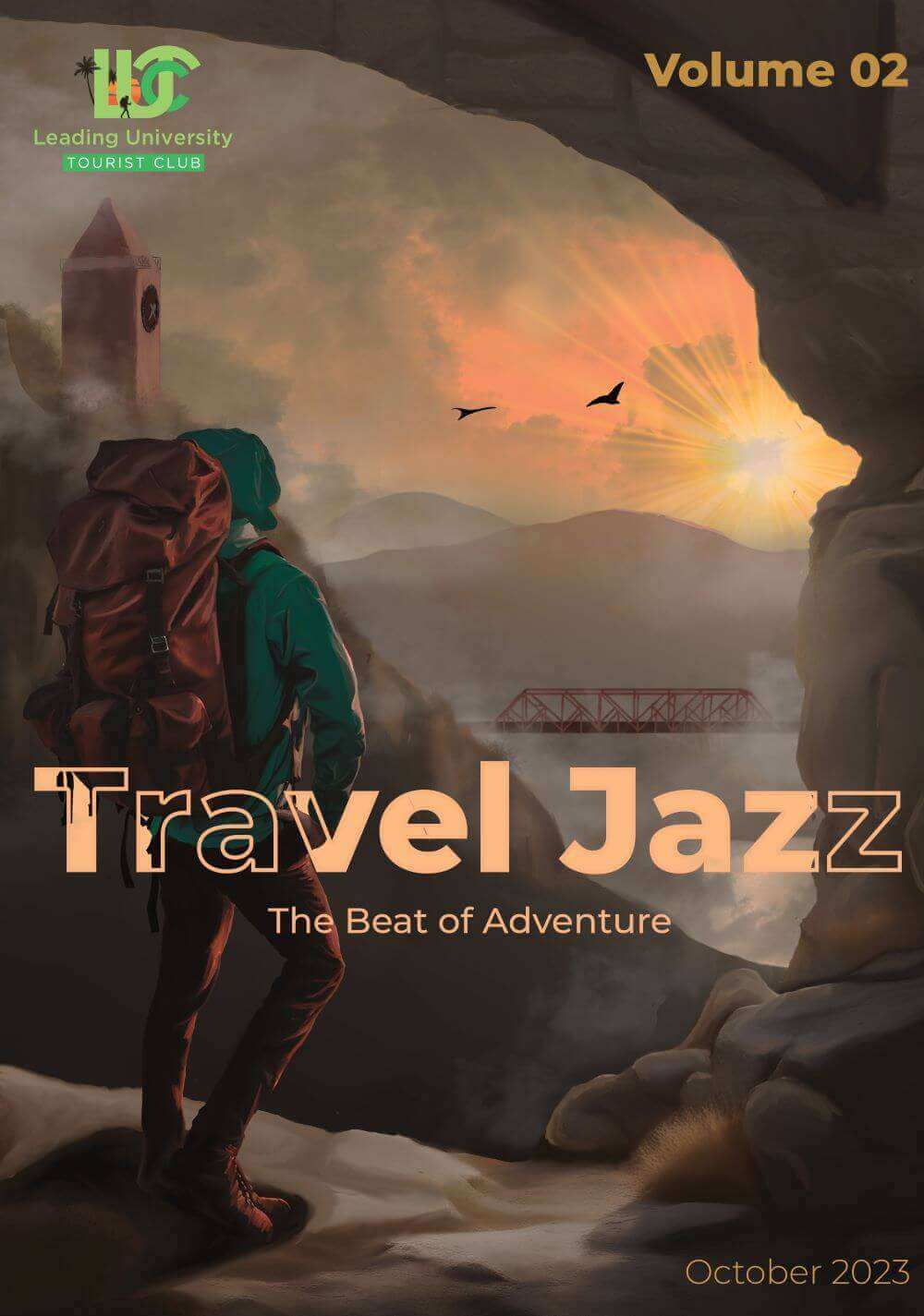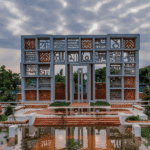Introduction: Tourism has been considered as a potent industry for exposing the soft power potential and large scale employment generation through complementary industries, enhance the movement of people and enable the people-to-people connectivity, sources of earning foreign exchange and increasing living standards. Tourism accelerates the understanding of history, culture and traditions, promotes national integration, develop universal brotherhood and social integration. South Asia has emerged as an attractive tourist destination due to its natural and cultural diversity as well as price competitiveness where the Northeast region of India and Bangladesh in the South Asia are seemingly considered as the corridor between the South-Asian Association for Regional Cooperation (SAARC) and the Association of Southeast Asian Nations (ASEAN) countries plus China. Bangladesh shares 1,879 kilometers of border with India’s north-eastern region which is the home to 475 ethnic groups that makes the region complex characterized by socioeconomic multiplicity and environmental diversity. The government of both India and Bangladesh has important roles to play in the provision of tourist services such as transport facilities including air, rail and road transport, easing passport and visa facilities, infrastructural facilities as hotels, lodges, guest houses and travel and tour agencies themselves. Ensuring appropriate competitive environment and framing and implementing policies to support and enhance the tourism industry. Bangladesh has been featured in India’s list of top ten tourist source countries due to its proximity and cultural linkages.
The Historical Importance of Bengal and Relationship between Bangladesh and North East Region of India: Bengal, Bengali or Bangla, has historical root in the northeastern part of the Indian Subcontinent that corresponds to the area inhabited by speakers of the Bangla language and now divided between the Indian state of West Bengal and the People’s Republic of Bangladesh. It has historical, geographical, ethno-linguistic and cultural heritages and similarity. The Indian states of Assam and Tripura have a sizeable Bengali population. A large Bengali diaspora exists across the world. Since antiquity population of this region are characterized by various Indo-Aryan, Dravidian and Austric. The Buddhist Pala Dynasty was founded in Bengal in the 8th century, based in what is now the Bihar state. The Sena dynasty and Deva dynasty ruled Bengal between the 11th and 13th Centuries. After 1200 it was conquests by Muslim rulers in 14th Century, formed an independent Bengal Sultanate and absorbed in the Indian Subcontinent that became the eastern frontiers of Islamic world. From 1576 it was belonged to the Mughal Empire. During this period Bengal rules and influences spread to Assam, Arakan, Tripura, Bihar and Odissa. The Mughal Bengal was the prosperous part of entire Mughal India. In the 18th century, a separate dynasty, Nawab’s Bengal, was emerged with Bengal, Bihar, and now Odisha state and continues until the 1756. British established themselves at Calcutta (Kolkata) in Western Bengal in 1690 and took possession of the Nawabs’ realm ruled from 1757 to 1764. The last independent Nawab of Bengal was defeated in 1757 at the Battle of Plassey by the British East India Company and grew Bengal Presidency into the largest administrative unit of British India where Calcutta (Kolkata) was the Capital of British India. The presidency stretched from Burma, Penang, Singapore and Malacca in the east to the Punjab and Ceded and Conquered Provinces in the west. Bengal was gradually re-organized by the early 20th century: first partition of Bengal Province consisting of Eastern Bengal and Assam existed between 1905 and 1911 with its capital in the former Mughal capital Dhaka. Following the Sylhet Referendum on 7 July of 1947 through votes by the Bengal Legislative Council and Bengal Legislative Assembly, the region was again divided along the religious lines. Bengali culture along with its literature, music, art and cinema are well known in South Asia and beyond, presence of notable economists and social scientists that includes Nobel Laureates once possessed the highest per capita income in the British India. Thus, from the historical evidences amplify that how Bangladesh and NER of India had a long historical linkage and cultural bondage and its pervasive influences between Indo-China and Japanese as well as South East Asian region. Upholding tourism industry and development of the facilitating infrastructures in these regions may go a long way for the greater development of the Bay of Bengal, SAARC, ASEAN, and BIMSTEC, China and Japan as well as SASEC countries under different sub regions.
Economic and Geostrategic Nexus of the Bay of Bengal Region having Central focus of Bangladesh and Northeast Region of India: These two regions have important economic and geostrategic importance to enhance connectivity among the Bay of Bengal Region (BBR) countries which is considered as the largest Bay in the world, SAARC, ASEAN and BIMSTEC countries. Countries under all these sub-regions are connected for many reasons having their multiple, collective and common, businesses, cultural and other interests. According to constricted scientific definition, the Bay of Bengal region includes the coastal states of Sri Lanka, India, Bangladesh, Myanmar, Thailand, and Indonesia – which geographically is positioned between the Indian Subcontinent and Indo-Chinese region. Nearly 1.4 billion people live in BBR and along its coastline which is almost a fourth of the world’s total population. In wider environmental and economic sense, any development in the Bay of Bengal is also intertwined with the destinies of the Himalayan states of Nepal and Bhutan, the Maldivian archipelago and the Malacca Strait’s, funnel state of Malaysia. Thus, by considering these wider view over two billion people live in and around this region where it has been observed unparalleled economic growth in recent times. Some countries are again connected with and under multiple sub-groups simultaneously. The Bay of Bengal has a divergent tropical marine ecosystem, and plentiful river drainage, the profusion of wetlands, marshes, and mangroves as well as increase productivity of near shore fish resources. The exploitation of these resources is carried out by small-scale fisheries and commercial fishing in deeper waters largely by countries bordering the bay and by Japan. Thus, Bangladesh and North East Region (NER) of India have been considered as hub and important geostrategic confluence which has immense potentials of increasing tourism industry and enhancing relationship among all the sub-regional networks and integration.
Revised Travel Arrangements (RTA) and Tourist Movements between India and Bangladesh: To enhance the travelling opportunities, easing the travelling formalities and liberalizing visa procedure for tourists, students and business people Bangladesh and India agreed to implement RTA. Under the RTA-2018 freedom fighters and elderly Bangladeshi nationals will get 5 years multiple visas from India. Difficulties in obtaining passport and visa have been reduced between Bangladesh and India and arrival of tourists have been increased tremendously due to RTA. This agreement generates opportunities for travel movement between Bangladesh and India as well as increases the tourist arrival between the countries. A sudden flow has been increased in the number of Bangladeshi tourist arrivals in India from 2014. In the period of 2003-2014, the growth of Bangladeshi tourist arrivals was 1%, although, the arrival of Bangladeshi tourists to India has been increased by 80% in the year 2014. After that, the number had been mounting at an average annual rate of 40%. In 2018, one in every four tourists from South Asia to India was from Bangladesh. It is partly due to RTA and removal of difficulties faced by the nationals of either country in obtaining a visa.
Characteristics of Bangladesh and NER of India Regarding Tourism:
Connectivity of India’s NER to the Bay of Bengal region via Bangladesh is a key building block of realizing the vision of a prosperous and vibrant Indo-Pacific region. It is also a gateway to East and Southeast Asia.
Bangladesh claims to have the world’s longest unbroken sea beach Cox’s Bazar, the world’s biggest mangrove forest and world heritage Sundarbans, Tanguar Haor and many wetlands and rivers and tourist spots of immense natural beauty. It has a very rich cultural heritages and old history of civilization. Visitors can avail the opportunity to enjoy the company of smiling and hospitable people of Bangladesh. The taste of typical delicious Bangladeshi foods especially the extravagant Hilsha fish of Bangladesh is ever enjoyable to all. It has panoramic beauties, passionate history, blossoming synergetic culture, enthralling archaeological sites, charming wildlife as well as the Royal Bengal Tigers. Other scenic beauties are Oceanic Kuakata, Coral island Saint Martin’s, the greenery features of Bandarban with colorful Indigenous population and their cultural diversity along with the lake city of Rangamati. The impressiveness of Dhaka city and the beauty of the Port City of Chittagong, and the spirituality of the Sylhet city along with villages, attract the imagination of tourists and visitors. Bangladesh is riverine country having about 700 small and big rivers. The Padma, the Meghna, the Jamuna are the big and wide rivers along with the Buriganga, the Sitalakshya, the Dhaleswari, the Teesta, the Madhumati, the Gumati, and the Karnafoli are small rivers. Most of the rivers rises from the Himalayas and falls into the Bay of Bengal. This is a fine land of tourists, researchers and wildlife and nature lovers where `there are many entrances but there is a single door to leave.
Bangladesh contains the Haor Basin consists of about 400 haors and beels (small ponds with static water) estimated to stretch over an area of between 4450 square kilometers and 2.5 million hectares that includes rivers, streams, irrigations canals, and vast areas of seasonally flooded cultivated plains. The Government of Bangladesh is working keenly to preserve the wetlands environment including Haor Basin is a destination of choice for a large number of birds where approximately 207 species of birds either live in or visit Bangladesh. These amazing places are most attractive as the sea beach or the mighty river where tourists from all over the world come to visit during the monsoon season when full of water and gets beautiful looks. During winter season these wetland becomes the home to thousands of migratory birds that gets the distinct beauty and is an ideal time for bird-watchers.
NER of India or Seven Sister States commonly attributed as an amalgamation of rippling hills, rolling valleys and tranquil hamlets. It comprises of the seven Indian states namely Arunachal Pradesh, Meghalaya, Assam, Manipur, Nagaland, Tripura and Mizoram. Sikkim is the newest addition and became the eighth states in the year 2002. NER is endowed with vast natural resources such as forest resources, petroleum products and hydroelectric power. Additionally, the strategic location of the region, which shares borders with Nepal, Bhutan, China, Myanmar, and Bangladesh, outperforms others in terms of potential gains from the international borders. India shares the longest international border with Bangladesh among all the neighboring countries. With ethno-geographic and bio-geographic, rich culture, heritage and natural flora and fauna, the NER is rightly called India’s permanent place for happiness.
Facilitating Cooperation and Connectivity between Bangladesh and NER of India for Enhancement of the Tourism Industry: Trade and connectivity are vital to bilateral ties. Provision for duty-free entry of Bangladeshi products into Indian markets and vice versa, investments in the development of infrastructure and the simplification of the visa process encourage and increase the cross-border movement of people and goods and hence the tourism industry in the multifaceted purposes. To strengthen regional connectivity and promote regional cooperation along with other platforms the BBIN (Bangladesh, Bhutan, India, Nepal) Motor Vehicle Agreement (MVA) plays the important role where both Bangladesh and are India signatories. With the functioning of BBIN-MVA the unrestricted movement of vehicles from the member countries will be increased via designated routes including cross-border area that again necessitates the development of border checkpoint facilities between the border of India and Bangladesh. The government of Bangladesh is committed to enhance sub-regional cooperation by the physical connectivity through the development of “rivers, roads and peoples” communication and cooperation in the spheres of tourism – including cultural, educational and religious tourism — and collaboration in trade and commerce that may facilitate a win-win situation and mutually beneficial relationship between the countries.
The northeastern land-locked region of India which is isolated from the main heartland India proceeds through the narrow and cumbersome chicken-neck Siliguri corridor where Bangladesh act as the causeway between the northeastern zone and the mainland India by using the existing rail, road, river and the air connectivity. For expansion of tourism between Bangladesh and the 7-sisters all the closed border check posts for tourists need to be opened and creation of more border check posts with infrastructural facilities including road and rail connectivity. Sylhet International airport can serve as the passageway for the isolated northeastern people towards rest of the world. The Integrated Check Posts (ICPs) with adequate passenger and freight-processing facilities and three main border-related functions: customs and clearance, Immigration as well as border Security providing backup support to customs and immigration need to be ensured. The India–Bangladesh border has around 38 Land Customs Stations (LCSs) as major sites of cross-border movement between the two countries which must have regulatory agencies such as customs and immigration as well as facilities for parking, quarantine and storage along with all other modernized facilities. But at present border crossing facilities between the countries are characterized by poor facilities, corruption, bureaucratic tangles and infrastructures deficit which makes border crossing time consuming and costly. Even there is not a single LCS between India and Bangladesh that offers services similar to the global standard.
Peoples Participation as a Key Points: The governments of the countries and states within the countries can’t achieve all rather it requires active participation of the people and engagement of all stakeholders more specifically participation of the civil society is mandatory to make the travel and tourism industry vibrant. Research organizations like Research and Development Collective (RDC) in Bangladesh and Asian Confluence in Meghalaya, India, interactions amongst universities, businesses, academics, artists, tourism industry, media and other stakeholders can play their catalytic role by exploring the new vista and opportunities for tourism industry development. Organizing seminars, workshop, cultural exchange programs, joint initiatives for preserving the monuments and archaeology, museums and visual Arts, National Science Museums, films and media, library and archives, performing arts and other intangible cultural heritage by which cultural exchange and upholding of tourism industry can be achieved between Bangladesh and NER of India.
The MV Ganga Vila Cruise: World’s Longest River Cruise between Bangladesh and India
The MV Ganga Vilas Cruise has been considered as the world’s longest river cruise covering a 3,200 km inland water route between Bangladesh and India connecting Varanasi in Uttar Pradesh to Dibrugarh in Assam and travels through Kolkata and Dhaka. The cruise will begin its journey from Varanasi in Uttar Pradesh and will reach Dibrugarh in Assam via Bangladesh in 51 days, sailing across 27 river systems in India and Bangladesh having three decks, 18 suites on board with a capacity of 36 tourists with all the luxury amenities. It will be an experiential cruise indulging the art, culture, history, and spirituality of India and Bangladesh. Journey through this voyage will provide opportunities to visit 50 Tourist Spots including 40 historic sites on the banks of the river Ganga, different National Parks, River Ghats, and major cities like Patna in Bihar, Sahibganj in Jharkhand, Kolkata in West Bengal, Dhaka in Bangladesh and Guwahati in Assam. Initiation of this cruise endeavors to boost river voyage tourism between Bangladesh and NER of India that will help to exploit huge untapped potential of river cruises by unlocking and heralding a new age of river cruise tourism in the region.
Figure: The Route Intermediate Points of MV Ganga Village Cruise
Source: https://pib.gov.in/PressReleasePage.aspx?PRID=1890895
Tourism and Green Investments: Collaboration between Bangladesh NER of India: Channeling investment projects that benefit the environment, is inevitable now a days to adjust climate change related risk perceptions in order to boost green and sustainable economic development and this is true and continuously growing importance in sustainable tourism or green investment in tourism development. Environmentally irresponsible investments are now creating abruptly air, water and land pollution that are damaging the natural ecosystems, eroding biodiversity and widening social inequity. Both Bangladesh and NER of India have the physical and human diversities and by considering that these regions have been considered as the most promising regions for the development of the eco-tourism or sustainable tourism or green tourism. For creating the enabling environment in these directions formal and non- formal financial institutions in Bangladesh are providing finance and assistances under the guidelines of Bangladesh Bank for developing enterprises in the sustainable tourism development. Tourism is the only clean, green, pollution-free, non-invasive, and employment-generating industry. NER of India also emphasizing on the development of infrastructure for sustainable tourism development focusing this issue in their different states. Environmental conservation plays a vital role in natural tourism where as it has been found that because of excessive tourist visit and lack of environmental consciousness among the tourists and as well as local community natural environment abruptly jeopardized that need to be contained. So, in this respect it is essential to enhance the investment in protecting the hill, mountains, forests resources, water resources and water bodies, flora and fauna with long run perspective plan and short term operational plan to uphold the nature tourism, green or eco or sustainable tourism. However, in this regards both Bangladesh and NER of India emphasized to enhance green investment for proliferation of the respective tourism sectors in the greater industry of tourism.
Constraining Factors to boost the Tourism Industry: In spite of having sincere efforts by the government of both the countries tourism industry in both the countries are facing manifold problems which become the impediments in the way of enhancing the tourism industry. The notable impediment factors are: regulations and excessive bureaucracy in different phases of the tourism, cumbersome processes for issuing visa and permits for foreign tourists by both the countries, lack of integration in visa regime and proper competitive environment as most of the tourist facilities are governed by the government which are maintaining poor business, professional and quality standards. Poor currency management and exchange rate systems, slow, labor intensive and inappropriate facilities at the Airports that make the international visitors uncomfortable, poor facilities in hotels, motels and other residential facilities, lack of digitalization of the tourist services all are creating impediments for facilitating the tourism industry both in Bangladesh and Seven Sisters or NER of India.
Specially, for Bangladesh tourism sector is stagnant till to date after 50 years of independence, ranks at the bottom of the world even lags behind many South Asian countries. Bangladesh ranks 100th out of 117 countries in the world according to the Travel and Tourism Development Index 2021, whereas India’s position is the 54th by considering the same index. Due to the shortage of real-time information and time consuming tour planning process Bangladesh is considered to be as challenging destination for travel enthusiasts.
Suggestions and Recommendations: Some suggestions and recommendations may be made for improvement of the tourism industry in Bangladesh and Seven Sisters in India. The specific recommendations are given below:
- Improving visa regime by reducing bureaucracy, reducing the time and introducing the e-visa, online visa, on arrival or on site visa. Achieving integration between the countries in issuing and managing the visa. Bring efficiency in the immigration related formalities.
- Public- private participation for ensuring tourism facilities, infrastructural development, owning and managing hotels, motels and other residential facilities and other relevant services for tourists.
- For ensuring the infrastructural facilities inter-ministerial coordination may be achieved along coordination of some internal departments and division within the country. For inter-country infrastructural development coordinated funding and management can be utilized by raking assistance from international agencies like as World Bank, Asian Development Bank, Japan International Cooperation Agency and using facilities created by the Sub regional groups along with inter country meeting at different levels, identifying the gap and problem, study taking and implementing relevant decisions for improvement of the tourism industry.
- Taking collective and integrated initiatives for promoting intra-regional tourism by different sub-regional groups like SAARC, BIMSTEC, BBIN like ASEAN. Organizing regional tourism summit, facilitating inter-regional cooperation among tour operators, making integration with the Federation of ASEAN Travel Associations (FATA). Organizing bilateral arrangements and cooperation with other South Asian countries on joint tourism promotion and advertising campaigns, towards establishing the tourism industry as a regional value chain.
- Organizing Tourism Forum for promoting specific tourism product, such as, green tourism forum or sustainable tourism or eco tourism, medical tourism, education tourism or cultural tourism etc. in the specific area each country or states in the NER of India should promote their product through own campaign program along with regional forum collectively.
- Enhancing security for the tourist, providing updated and timely information, providing site based internet facilities and taking less time for making the tour plan are some notable initiatives to enhance the tourism industry.
Conclusion: Tourism industry has been considered as a potent industry throughout the world which has an important implication for employment generation in largest scale by different complementary industries. Historically Bangladesh and Northeast Region of India has a good nexus as per as similarity of languages in some areas as well as geographical proximity, diversity of nature and language, culture, geographical formation etc. By considering all these factors present study found huge potentials of collaboration between two regions for upholding the tourism industry. Where there are some constraining factors that need to be ironed out. Suggestions have been made for upholding the sector in both the regions through collaborations, development of the infrastructures, joint promotion, enhancing administrative efficiency, easiness in issuing visa and creating tourist support culture, ensuring participation of the people for the development of the sector etc. However the study identified the MV Ganga Vila Cruise as the world’s longest river cruise between Bangladesh and India









